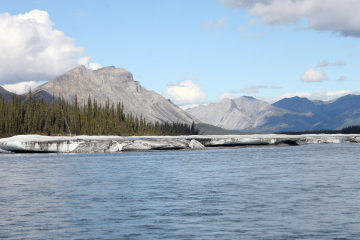What do you think about when you imagine the Arctic National Wildlife Refuge? Braided rivers snaking through the moss and sedge of an endless tundra? Coastal lagoons packed with sea ice and alive with the chatter of ringed seals? The isolated, frozen peaks of the Brooks Range?
Perhaps, instead, you think of the ongoing (and largely partisan) debate about whether an exception should be made to allow drilling for oil and natural gas within the refuge. This article will attempt to address some of the key reasons for keeping this area pristine and free from development.
A Legacy of Protection
Federally protected in 1960 and expanded significantly in 1980, the Arctic National Wildlife Refuge (ANWR) has no roads within it, nor any roads leading to it. Eight million of its 19 million acres are designated wilderness, including much of the spectacular Brooks Range. Within it, at the headwaters of the Sheenjek River, you’ll find the most remote place in the United States. It is the single point farthest from any roads or cities. It preserves a greater variety of plant and animal life than any other in the Arctic Circle, and is critical to the survival of the Gwich’in Nation.
This is truly a wild place. In 1953, an article in the Sierra Club journal dubbed it "the last great wilderness."
"Here still survives one of Planet Earth's own works of art," wrote co-author Lowell Sumner. 64 years later, the region is still remarkably untrammeled by man, despite an oil-drilling controversy which has boiled since at least 1977.
"It takes a lot of territory to keep this alive, a living wilderness, for scientific observation and for esthetic inspiration. The Far North is a fragile place." — Olaus Murie, 1963
Along the Arctic National Wildlife Refuge’s northern coast, lagoons and river deltas provide habitat for sea ducks and shorebirds, as well as migrating snow geese. This coastal land and adjacent sea ice are used by polar bears hunting seals and birthing their cubs in snow dens during winter. In summer, caribou travel to the coastal plain to birth and raise their own calves among the mossy tundra. This is the "1002 Area", the region being considered for oil drilling.
Environmental Risks & Realities
Why the controversy? It’s a question of risk versus reward. Is extracting and transporting oil and natural gas worth the unavoidable ecological impact? Is it worth the risk of a major oil spill?
Environmental and geologic assessments have been mixed as to the actual amount of recoverable oil in the region, but unanimous regarding the negative ramifications a network of oil platforms, pipelines and roads would have on native wildlife.
"I strongly reject drilling in the Arctic National Wildlife Refuge because it would irreversibly damage a protected national wildlife refuge without creating sufficient oil supplies to meaningfully affect the global market price or have a discernible impact on U.S. energy security." — Barack Obama, 2007
This wildlife includes the Porcupine Herd caribou, a significant migratory herd comprised of approximately 169,000 animals as of 2017. The coastal plain of the refuge is their calving ground and development is likely to push them into the foothills of the Brooks Range (where calves would be far more susceptible to predation) or force them to abandon the region entirely. The latter would be a worst-case scenario for the Gwich’in people.
The Gwich’in People
For those of us in the continental United States, the Arctic seems like an incredibly distant place. For the indigenous Gwich’in people, though, this is their backyard. Neets'aii Gwich'in translates as "those who dwell to the north," and the settlement of Arctic Village is certainly that—over 200 miles north of Fairbanks and accessible only by plane.
Approximately 9,000 Gwich’in live throughout the Yukon Territory of Canada and northern Alaska, clustered into 15 distinct communities including Arctic Village. Each community is on or near the migration path of the Porcupine caribou and the Gwichi’in people rely on the caribou as a vital source of food and clothing.
These are the self-described "Caribou People," and they fear the destruction of their lifestyle. Since forming the Gwich’in Steering Committee in 1988, they have continued to ask U.S leaders to permanently protect the the refuge’s coastal plain. According to the Gwich’in Steering Committee:
Our elders recognized that oil development in caribou calving grounds was a threat to the very heart of our people. They called upon the chiefs of all Gwich’in villages from Canada to Alaska to come together for a traditional gathering – the first in more than a century. At the gathering in Arctic Village we addressed the issue with a talking stick in accordance with our traditional way, and decided unanimously that we would speak with one voice against oil and gas development in the birthing and nursing grounds of the Porcupine Caribou Herd.
In addition, the Alaska Inter-Tribal Council (representing 229 tribes), the Tanana Chiefs Conference (representing 37 tribes), the National Congress of American Indians (representing 250 tribes) and the Native American Rights Fund officially oppose drilling in the 1002 area.
The International Covenant on Civil and Political Rights (ICCPR), a treaty adopted by the United Nations in 1966 and ratified by the United States, declares: "In no case may a people be deprived of its own means of subsistence." This, unfortunately, is exactly what would befall the Gwich’in should drilling be allowed in the refuge.
A Need for Action
The Trump administration, in conjunction with a GOP majority and the Department of the Interior, is currently rushing legislation through congress to open up drilling and fracking for oil and natural gas in the refuge. Even as you read this, the matter is being openly considered. The threat is real.
To learn about what you can do to protect the Arctic National Wildlife Refuge and the Gwich’in communities, click here.
Originally written by RootsRated Media for Sierra Club.
